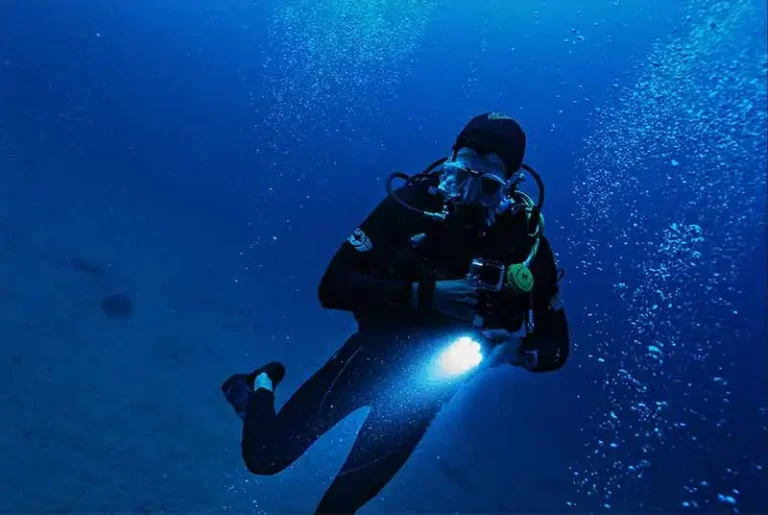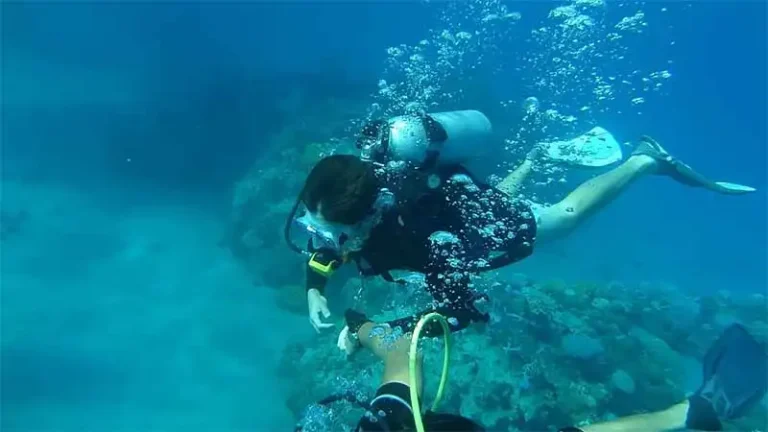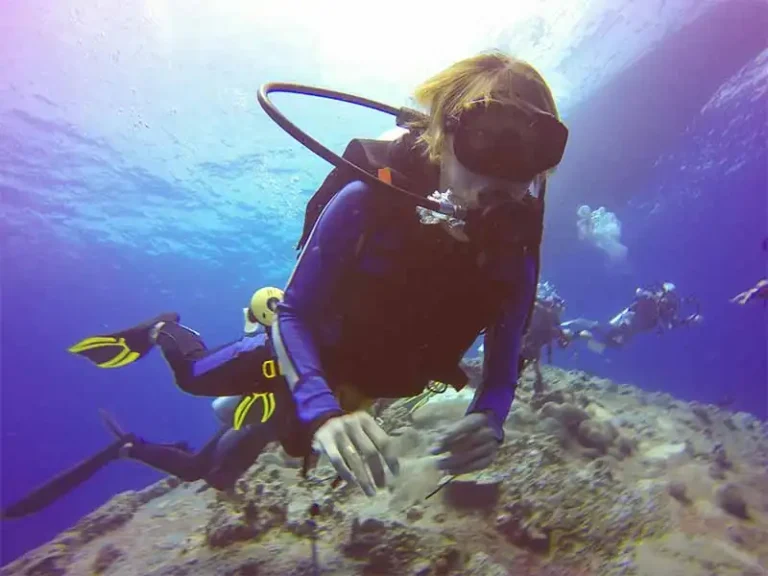Why Split Fins Are Popular Among Divers: Pros and Cons
Split fins have become increasingly popular among scuba divers in recent years, offering a unique alternative to traditional paddle fins.
These fins are designed with a distinct split in the blade, which allows water to flow more efficiently through the fins during a diver’s kick.
This streamlined design can help reduce fatigue and increase speed, making them an appealing choice for many divers.
However, split fins are also a topic of debate within the diving community. Some divers swear by their efficiency and comfort, while others argue that they lack the power needed for certain diving conditions.
This ongoing debate has made split fins a point of interest for those looking to invest in new scuba diving gear.
The purpose of this blog is to dive deeper into the pros and cons of split fins, providing a balanced view of their benefits and drawbacks.
By the end, you’ll have a clearer understanding of why divers choose split fins and whether they are the right choice for your diving adventures.
Whether you’re a beginner looking for comfort or an experienced diver seeking efficiency, this guide will help you make an informed decision about your diving fins.
What Are Split Fins?
Split fins are a type of scuba diving fin known for their distinctive design, where the blade of the fin is split into two separate sections.
This design is meant to help reduce drag and improve the flow of water around the fin as the diver kicks, making the finning motion more efficient.
When a diver kicks with split fins, the water flows smoothly through the split, resulting in a more powerful push with less effort.
This can be particularly helpful for divers who want to conserve energy during longer dives or in situations where reducing fatigue is important.
In contrast to traditional paddle fins, which have a solid, wide blade, split fins feature a more flexible design.
Paddle fins work by pushing against the water with their full surface area, creating more resistance and requiring more strength to move.
On the other hand, split fins use a narrower blade with the split serving to guide water in a way that reduces drag and makes the kicking motion smoother and more efficient.
The primary purpose of split fins is to make diving less tiring, especially for those who dive for long periods or are diving in calm waters.
They provide excellent propulsion while using less energy, which can be a game-changer for beginners and divers with limited strength or endurance.
However, it’s important to note that while they offer efficiency, they may not perform as well in strong currents or when quick, powerful bursts of movement are required, as split fins typically lack the high thrust power of paddle fins.
Benefits of Split Fins
Split fins are favored by many divers for their efficiency and comfort, offering several key advantages that make them stand out from traditional paddle fins.
Here are the main benefits that divers experience when using split fins:
Increased Efficiency
One of the most significant advantages of split fins is their ability to reduce drag while improving propulsion.
The split design allows water to flow through the fins more smoothly, which means less effort is required for each kick.
This results in more efficient movement through the water with less resistance. As a result, divers can cover more distance with less energy, making split fins ideal for long dives or when conserving energy is essential.
Efficient diving fins can be particularly useful in situations where you need to maintain a steady pace without overexerting yourself.
Reduced Muscle Fatigue
For divers who spend long hours underwater or those with physical limitations, split fins can significantly reduce muscle fatigue.
Traditional fins require more forceful kicking to achieve the same propulsion, which can quickly tire out the legs, especially during lengthy dives.
With split fins, the design allows for a gentler kick that requires less strength, which helps conserve energy and reduces overall fatigue.
This makes split fins a great choice for divers who want to extend their dive times without feeling exhausted or for those who may struggle with muscle endurance.
Ease of Use
Split fins are also known for being beginner-friendly. They are easy to use and require less effort to move through the water compared to traditional fins.
This makes them an excellent option for new divers who are still developing their kicking technique or for those who simply want a more comfortable and relaxed diving experience.
The energy-saving fins help beginners focus on other aspects of diving, like buoyancy control, without worrying about tiring out too quickly.
Whether you are just starting out or looking for a comfortable option for your regular dives, split fins offer a smooth and hassle-free experience.
Overall, the benefits of split fins make them a popular choice for divers who prioritize comfort, efficiency, and ease of use, whether they are diving for longer periods or simply looking for a more relaxing experience underwater.
Drawbacks of Split Fins
While split fins offer numerous advantages, they also come with some drawbacks that divers should consider before choosing them.
Understanding these limitations can help you make an informed decision based on your diving needs.
Here are the main disadvantages of split fins:
Limited Power
One of the main drawbacks of split fins is their limited power in certain conditions. While split fins excel at efficiency and reducing drag in calm waters, they are not the best option for diving in strong currents or situations that require rapid movement.
Since the split design focuses on reducing resistance and offering a smoother, more efficient kick, it may not generate the same amount of thrust as traditional paddle fins.
For divers who need quick bursts of speed or need to navigate strong underwater currents, split fins may not provide the power needed to handle these challenges effectively.
This limitation is something to keep in mind if you frequently dive in rough conditions or need maximum propulsion.
Learning Curve
Another drawback of split fins is the learning curve associated with their unique kicking technique.
Unlike paddle fins, which require a more straightforward flutter kick, split fins need a slightly different approach to maximize their efficiency.
Beginners may initially struggle to adjust their kicking motion to get the most out of the fins, and it can take some time to develop the proper technique.
For divers who are accustomed to traditional fins, this adjustment may feel awkward at first.
While many divers quickly get the hang of split fins, it’s important to be prepared for a period of adaptation as you fine-tune your kicking style.
Cost
Finally, split fins are often more expensive than traditional paddle fins. The advanced design and materials used in making these fins can drive up the price, making them a significant investment for some divers.
If you’re on a budget, the higher cost of split fins compared to paddle fins may be a concern.
However, the increased efficiency and comfort they provide may justify the cost for many divers, especially those who prioritize comfort or plan to dive for extended periods.
In conclusion, while split fins offer impressive benefits, it’s important to weigh these drawbacks before making a decision.
If you dive in strong currents, need rapid movements, or are on a tight budget, you may want to consider other options or carefully evaluate how split fins fit into your specific diving style.
When to Choose Split Fins Over Paddle Fins?
Choosing between split fins and paddle fins depends largely on the type of diving you plan to do and the diving conditions you’ll encounter.
Understanding the unique advantages of split fins can help you decide when they are the best option for your diving experience.
Here are some key considerations for choosing split fins over paddle fins:
Ideal Conditions for Using Split Fins
Split fins are best suited for calm waters and relaxed diving conditions. Their design is optimized to reduce drag and provide efficient movement with minimal effort, which makes them ideal for recreational divers who plan to enjoy leisurely dives.
In situations where power and speed are less important, such as shallow dives or exploring vibrant coral reefs, split fins can help you move effortlessly through the water while conserving energy.
These fins are particularly effective when energy conservation is a priority, allowing you to dive longer and more comfortably without fatigue.
If you’re planning dives in relatively calm conditions, such as those in tropical waters or during scenic, shallow dives, split fins are often the best fins for recreational diving.
They offer comfort and efficiency for those who are looking to experience the underwater world without having to work too hard.
Comparison of Diving Environments (Calm Waters vs. Strong Currents)
While split fins excel in calm waters, they are not as well-suited for strong currents or more challenging diving environments.
The unique design of split fins reduces resistance and increases efficiency, but it also limits their ability to generate the high thrust needed to combat strong underwater currents.
If you’re diving in strong currents or need rapid propulsion, paddle fins may be the better choice, as their solid, wide blades provide more powerful thrust to help you navigate against the flow of water.
On the other hand, if your diving environment features calm seas, split fins allow you to glide through the water with ease, making them a great choice for divers looking to minimize effort and maximize comfort.
Suitability for Recreational Diving vs. Technical Diving
Split fins are often favored by recreational divers due to their ease of use and comfort, making them ideal for those who engage in non-technical diving activities.
For activities such as snorkeling, reef exploration, or shallow water diving, split fins offer the right balance of efficiency and ease, allowing divers to focus on the experience rather than exerting unnecessary effort.
However, when it comes to technical diving, such as deep diving, cave diving, or diving in challenging conditions, paddle fins may be more suitable.
Technical divers often require more power and control, especially when navigating strong currents or handling complex underwater terrain.
The additional thrust provided by paddle fins can help divers maintain stability and maneuverability in these demanding environments.
In conclusion, split fins are an excellent choice for recreational diving in calm waters, offering comfort and energy efficiency.
If your diving requires navigating strong currents or tackling more challenging dive sites, paddle fins might be the better option.
Understanding the diving conditions you’ll face will guide you in choosing the right fins for your needs, ensuring that you have the best equipment for a safe and enjoyable dive.
Split Fins vs. Paddle Fins: Key Differences
When choosing between split fins and paddle fins, it’s essential to understand how each type performs in various diving conditions.
Both have their own set of advantages and drawbacks, making them suitable for different types of divers and diving environments.
Below is a side-by-side comparison of split fins and traditional paddle fins based on three key factors: performance, comfort, and durability.
Performance
Split Fins
Designed to reduce drag and increase efficiency, split fins excel in calm, shallow waters where energy conservation is crucial.
Their split design allows water to flow more smoothly through the fins, resulting in less resistance and a smoother kick.
However, they may not provide the high thrust needed for navigating strong currents or rapid movements.
Paddle Fins
Paddle fins are built for power and provide more thrust, making them ideal for technical dives or situations requiring quick movements and strong propulsion.
The solid blade design offers greater surface area to push against the water, making them more effective in strong currents and deeper dive environments.
Comfort
Split Fins
One of the standout features of split fins is their comfort. They require less effort to kick, which reduces muscle fatigue and allows divers to enjoy longer dives with less strain on their legs.
Their lightweight and flexible design also make them easier to use for beginners or divers who want a more relaxed diving experience.
Paddle Fins
Paddle fins can be less comfortable for some divers, especially for extended dives. Their design requires more forceful kicking to achieve propulsion, which can lead to increased muscle fatigue, particularly for beginners or divers with limited strength.
However, their stability and control in turbulent waters make them comfortable for divers who require powerful movement.
Durability
Split Fins
The durability of split fins depends on the materials used in their construction, which can vary by brand.
In general, split fins are durable but may be more prone to wear over time compared to paddle fins, especially in rugged conditions.
Their flexible design may also be more susceptible to damage from sharp objects or heavy impacts.
Paddle Fins
Paddle fins are typically known for their sturdiness. The solid construction and wider blade often make them more resistant to wear and tear, particularly in challenging diving environments like caves or wrecks.
The durability of paddle fins is one reason why they are preferred for technical diving.
Here is a quick comparison table to summarize the pros and cons of split fins and paddle fins:
|
Split Fins |
Paddle Fins | |
|---|---|---|
|
Performance |
Excellent efficiency in calm waters, but limited thrust in strong currents. |
Provides powerful thrust, ideal for strong currents and deep dives. |
|
Comfort |
Comfortable, easy on muscles, ideal for long dives and beginners. |
Can be less comfortable, especially for extended dives or beginners. |
|
Durability |
Durable, but may be more prone to damage over time. |
Generally more durable, suitable for challenging conditions. |
|
Best for |
Recreational divers, long, calm dives, energy conservation. |
Technical divers, deep dives, or diving in strong currents. |
|
Cost |
More affordable than paddle fins in many cases. |
Often more expensive, especially for high-performance models. |
In the split fins vs traditional fins debate, the best choice depends on your diving style and environmental conditions.
Split fins are a great option for recreational diving and energy-efficient dives, while paddle fins shine in high-thrust situations and challenging environments.
By considering the factors of performance, comfort, and durability, you can choose the right type of fins to suit your needs.
How to Choose the Right Fins for Your Needs
Choosing the right fins for your diving needs is a crucial decision that can significantly impact your overall diving experience.
The fins you select should align with your diving style, fitness level, and budget, among other factors.
Here’s a guide to help you make an informed decision when buying split fins or paddle fins.
Factors to Consider
Diving Style
The type of diving you plan to do will play a major role in your choice of fins. If you primarily engage in recreational diving in calm waters, split fins are a great choice due to their efficiency and comfort.
They’ll allow you to conserve energy and enjoy longer, more relaxed dives. On the other hand, if you often dive in strong currents or participate in technical diving, paddle fins may be more appropriate due to their ability to generate more thrust and provide stability in challenging environments.
- For recreational diving: Look for comfortable, easy-to-use fins that focus on energy conservation.
- For technical or deep diving: Opt for paddle fins that provide powerful thrust and control.
Fitness Level
Your fitness level and physical condition are important when selecting fins. Split fins are a fantastic option for divers who may have limited strength or endurance, as they require less effort to use, reducing muscle fatigue.
If you are a beginner or have physical limitations, split fins can make diving more enjoyable and less tiring.
However, if you’re physically fit and want to generate more power with each kick, paddle fins might be the better choice.
- For beginners or divers with physical limitations: Choose split fins for ease of use and comfort.
- For experienced divers: Paddle fins may offer more power for strong kicks and rapid movements.
Budget
The cost of diving fins can vary widely, so your budget will play a role in your decision. Split fins are often more affordable compared to high-performance paddle fins, which can be more expensive due to their robust design and ability to handle challenging dive environments.
Consider how much you’re willing to spend based on the features and quality you need for your specific diving activities.
- For a tighter budget: Look for split fins, which offer great value for recreational divers.
- For a higher budget: Invest in paddle fins if you’re diving in tough conditions or need more durability and power.
Tips for Testing Fins Before Purchasing
Before committing to a purchase, it’s a good idea to test the fins to ensure they are comfortable and suited to your needs.
Here are some helpful tips:
Try Them On
Visit a local dive shop and try on the fins to check their fit and comfort. Make sure the foot pocket fits snugly, but not too tight, to avoid discomfort during the dive.
The strap should also be adjustable for a secure fit.
Test the Flexibility
Flexibility is an important factor in how well the fins will perform. For split fins, check for flexibility in the blade to ensure smooth movement.
For paddle fins, make sure they are stiff enough to provide the necessary thrust without being too rigid.
Check for Comfort
Walk around in the fins to get a feel for their comfort level. A fin should feel comfortable when worn for extended periods.
Keep in mind that comfort is especially important for long dives.
Consider the Environment
If you dive in warm waters, lightweight and flexible fins might be best. For cold water diving, consider sturdier fins that provide better propulsion and control in stronger currents.
Seek Recommendations
Don’t hesitate to ask other divers or instructors for recommendations on the best fins for your diving style.
Reviews and feedback from experienced divers can offer valuable insight into the performance and durability of different fins.
When choosing the right diving fins, consider your diving style, fitness level, and budget.
Whether you choose split fins for their comfort and efficiency or paddle fins for their power and durability, the right fins will enhance your diving experience.
By testing fins before purchasing and following these scuba gear tips, you can make a choice that fits your needs and diving goals.
Frequently Asked Questions about Split Fins
Are Split Fins Good for Beginners?
Yes, split fins are an excellent choice for beginner divers. The energy-saving design of split fins makes them easier to use, especially for those who are still learning the ropes of diving.
The lightweight construction reduces fatigue and strain on the legs, allowing new divers to enjoy longer dives without feeling overly tired.
Additionally, the forgiving nature of split fins helps beginners master the proper kicking technique with less effort, making them more comfortable to use than some traditional fins.
Can You Use Split Fins in Strong Currents?
While split fins are designed for efficiency and comfort, they may not be the best option for strong currents or situations requiring rapid propulsion.
Traditional paddle fins often provide more powerful thrust in these conditions, as their design allows for a more forceful kick.
However, if you’re a diver who enjoys leisurely dives in calm waters or shallow dives in moderate conditions, split fins are more than capable of providing sufficient propulsion.
If you plan to dive in strong currents regularly, you may want to consider a more powerful fin designed for those specific conditions.
How Do I Maintain My Split Fins?
Proper maintenance of your scuba diving fins is crucial for ensuring their longevity and continued performance.
Here are some tips for keeping your split fins in top condition:
Rinse after each dive: Always rinse your fins with freshwater to remove saltwater, sand, and debris that could cause wear and tear.
Dry properly: After rinsing, ensure your fins are completely dry before storing them to prevent mold or mildew from developing.
Store in a cool, dry place: Avoid leaving your fins in direct sunlight or in overly humid environments, as this can cause the rubber or material to degrade.
Inspect regularly: Check for any signs of damage, such as cracks or tears in the blades or foot pockets, and repair or replace them as necessary to ensure safe diving.
Do Split Fins Work Well in Cold Water?
Yes, split fins can be used in cold water diving, but they may not perform as well as traditional fins in terms of providing the extra power needed to move through cold, dense water.
However, many divers find that the reduced drag and efficiency of split fins still allow for a comfortable diving experience in colder temperatures, especially if the dive is not in challenging conditions.
For cold water divers, it’s important to ensure that your wetsuit and other gear are appropriately insulated to make the dive as comfortable as possible.
Are Split Fins More Expensive Than Paddle Fins?
In general, split fins tend to be more expensive than traditional paddle fins due to their advanced design and materials.
The efficiency and reduced fatigue they offer come at a premium, and you may find that the investment is well worth it, especially if you’re a diver who values comfort during long dives.
While paddle fins can be less costly, many divers find that the added benefits of split fins justify the higher price.
Read More;







